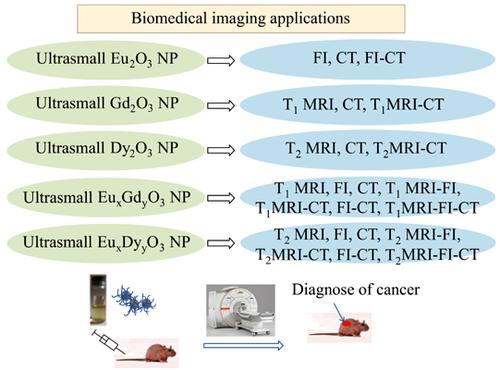Mini-Reviews in Medicinal Chemistry ( IF 3.3 ) Pub Date : 2020-09-30 , DOI: 10.2174/1389557520666200604163452 Huan Yue 1 , Ja Young Park 1 , Yongmin Chang 2 , Gang Ho Lee 1

|
Imaging agents are crucial in diagnosing diseases. Ultrasmall lanthanide oxide (Ln2O3) nanoparticles (NPs) (Ln = Eu, Gd, and Dy) are promising materials as high-performance imaging agents because of their excellent magnetic, optical, and X-ray attenuation properties which can be applied as magnetic resonance imaging (MRI), fluorescence imaging (FI), and X-ray computed tomography (CT) agents, respectively. Ultrasmall Ln2O3 NPs (Ln = Eu, Gd, and Dy) are reviewed here. The reviewed topics include polyol synthesis, characterization, properties, and biomedical imaging applications of ultrasmall Ln2O3 NPs. Recently published papers were used as bibliographic databases. A polyol method is a simple and efficient one-pot synthesis for preparing ultrasmall Ln2O3 NPs. Ligand-coated ultrasmall Ln2O3 NPs have good colloidal stability, biocompatibility, and renal excretion ability suitable for in vivo imaging applications. Ultrasmall Eu2O3 NPs display photoluminescence in the red region suitable for use as FI agents. Ultrasmall Gd2O3 NPs have r1 values higher than those of commercial molecular contrast agents and r2/r1 ratios close to 1, which make them eligible for use as T1 MRI contrast agents. Ultrasmall Dy2O3 NPs exhibit high r2 and negligible r1 values, which make them suitable for use as T2 MRI contrast agents. All ultrasmall Ln2O3 NPs have high X-ray attenuation powers which make them suitable for use as CT contrast agents. Unmixed, mixed, or doped ultrasmall Ln2O3 NPs with different Ln are extremely useful for in vivo imaging applications in MRI, CT, FI, MRI-CT, MRI-FI, CT-FI, and MRI-CT-FI.
中文翻译:

超小Euro,Ga和氧化s纳米颗粒:多元醇的合成,性质和生物医学成像应用
成像剂在诊断疾病中至关重要。超小型镧系元素氧化物(Ln 2 O 3)纳米颗粒(NPs)(Ln = Eu,Gd和Dy)具有出色的磁性,光学和X射线衰减特性,因此有望成为高性能成像剂。分别作为磁共振成像(MRI),荧光成像(FI)和X射线计算机断层扫描(CT)代理。本文对超小型Ln 2 O 3 NP(Ln = Eu,Gd和Dy)进行了综述。审查的主题包括超小Ln 2 O 3的多元醇合成,表征,性质和生物医学成像应用NP。最近发表的论文被用作书目数据库。多元醇方法是一种用于制备超小Ln 2 O 3 NP的简单有效的一锅合成方法。配体包裹的超小Ln 2 O 3 NP具有良好的胶体稳定性,生物相容性和肾脏排泄能力,适用于体内成像应用。超小型Eu2O3 NP在适合用作FI试剂的红色区域显示光致发光。Gd2O3超小型NP的r1值高于商业分子造影剂,r2 / r1的比率接近1,这使其有资格用作T1 MRI造影剂。超小型Dy2O3 NP的r2值较高,而r1值可忽略不计,因此适合用作T2 MRI造影剂。所有超小型Ln2 O 3 NP具有较高的X射线衰减能力,使其适合用作CT造影剂。具有不同Ln的未混合,混合或掺杂的超小Ln2O3 NP对于MRI,CT,FI,MRI-CT,MRI-FI,CT-FI和MRI-CT-FI的体内成像应用极为有用。











































 京公网安备 11010802027423号
京公网安备 11010802027423号